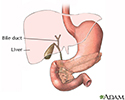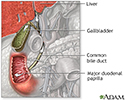Percutaneous transhepatic cholangiogram
PTCA; Cholangiogram - PTCA; PTC; PBD-Precutaneous Biliary drainage
A percutaneous transhepatic cholangiogram (PTCA) is an x-ray of the bile ducts. These are the tubes that carry bile from the liver to the gallbladder and small intestine.
How the Test is Performed
The test is performed in a radiology department by a radiologist.
You will be asked to lie on your back on the x-ray table. The provider will clean the upper right and middle area of your belly area and then apply a numbing medicine.
X-rays are used to help the health care provider locate your liver and bile ducts. A long, thin, flexible needle is then inserted through the skin into the liver. The provider injects dye, called contrast medium, into the bile ducts. Contrast helps highlight certain areas so they can be seen. More x-rays are taken as the dye flows through the bile ducts into the small intestine. This can be seen on a nearby video monitor.
You will be given medicine to calm you (sedation) for this procedure.
How to Prepare for the Test
Inform your provider if you are pregnant. You will be given a hospital gown to wear and you will be asked to remove all jewelry.
You will be asked not to eat or drink anything for 6 hours prior to the exam.
Tell your provider if you are taking any blood thinners such as warfarin (coumadin), Plavix (clopidrogrel), Pradaxa, or Xarelto.
How the Test will Feel
There will be a sting as the anesthetic is given. You may have some discomfort as the needle is advanced into the liver. You will have sedation for this procedure.
Why the Test is Performed
This test can help diagnose the cause of a bile duct blockage.
Bile is a liquid released by the liver. It contains cholesterol, bile salts, and waste products. Bile salts help your body break down (digest) fats. A blockage of the bile duct can lead to jaundice (yellow discoloration of the skin), itching of the skin, or infection of the liver, gallbladder or pancreas.
When it is performed, PTCA is most often the first part of a two-step process to relieve or treat a blockage.
- The PTCA makes a "roadmap" of the bile ducts, which can be used to plan the treatment.
- After the roadmap is done, the blockage can be treated by either placing a stent or a thin tube called a drain.
- The drain or stent will help the body get rid of the bile from the body. That process is called Percutaneous Biliary Drainage (PTBD).
Normal Results
The bile ducts are normal in size and appearance for the age of the person.
Bile
Bile is a fluid that is made and released by the liver and stored in the gallbladder. Bile helps with digestion. It breaks down fats into fatty acid...

What Abnormal Results Mean
The results may show that the ducts are enlarged. This may mean the ducts are blocked. The blockage may be caused by scarring or stones. It may also indicate cancer in the bile ducts, liver, pancreas, or region of the gallbladder.
Risks
There is a slight chance of an allergic reaction to the contrast medium (iodine). There is also a small risk of:
- Damage to nearby organs
- Excessive blood loss
- Blood poisoning (sepsis)
- Inflammation of the bile ducts
Considerations
Most of the time, this test is done after an endoscopic retrograde cholangiopancreatography (ERCP) test has been tried first. The PTC may be done if an ERCP test cannot be performed or has failed to clear the blockage.
A magnetic resonance cholangiopancreatography (MRCP) is a newer, noninvasive imaging method, based on MRI. It also provides views of the bile ducts, but it is not always possible to do this exam. Also, MRCP cannot be used to treat the blockage.
References
Lidofsky S. Jaundice. In: Feldman M, Friedman LS, Brandt LJ, eds. Sleisenger and Fordtran's Gastrointestinal and Liver Disease . 9th ed. Philadelphia, PA: Elsevier Saunders; 2010:chap 20.
Wael EA. Saad MJ, Wallace JC, Wojak SK. Quality improvement guidelines for percutaneous transhepatic cholangiography, biliary drainage, and percutaneous cholecystostomy. Journal of Vascular and Interventional Radiology . Vol. 21, Issue 6, June 2010:pp.789-95. PMID: 20307987 www.ncbi.nlm.nih.gov/pubmed/20307987 .
-
Gallbladder anatomy - illustration
The gallbladder is located in the abdomen, on the right side, underneath the liver. The gallbladder stores bile produced by the liver and delivers it to the first part of the small intestine (duodenum), where it aids in the digestion of fat
Gallbladder anatomy
illustration
-
Bile pathway - illustration
The biliary system is comprised of the organs and duct system that create, transport, store and release bile into the duodenum for digestion. Includes the liver, gallbladder and bile ducts (named the cystic, hepatic, common, and pancreatic duct).
Bile pathway
illustration
-
Gallbladder anatomy - illustration
The gallbladder is located in the abdomen, on the right side, underneath the liver. The gallbladder stores bile produced by the liver and delivers it to the first part of the small intestine (duodenum), where it aids in the digestion of fat
Gallbladder anatomy
illustration
-
Bile pathway - illustration
The biliary system is comprised of the organs and duct system that create, transport, store and release bile into the duodenum for digestion. Includes the liver, gallbladder and bile ducts (named the cystic, hepatic, common, and pancreatic duct).
Bile pathway
illustration
Review Date: 1/18/2015
Reviewed By: Jason Levy, MD, Northside Radiology Associates, Atlanta, GA. Also reviewed by David Zieve, MD, MHA, Isla Ogilvie, PhD, and the A.D.A.M. Editorial team.


